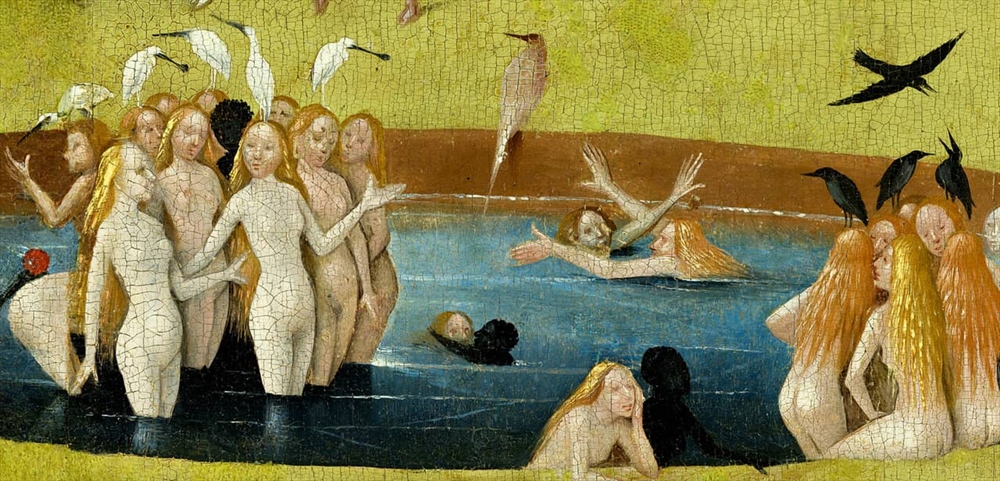1500 – 1505. Grisaille, Oil on oak panel
The Garden of Earthly Delights is one of Bosch’s most enigmatic creations, so any effort to discover its meaning requires identifying what is represented on each panel. The closed triptych is a grisaille depiction of the third day of Creation. The open triptych contrasts brilliant colors with the grays of the closed image. Its three panels are distributed in three overlapping planes, thanks to the elevation of the horizon. The left shows the Earthly Paradise, with God in the foreground -identifiable in appearance with Christ- between Adam and Eve and with a dragon tree on his left.
That tree from the Canary Islands is associated with the Tree of Life. This, then, is a presentation of Adam and Eve, a highly uncommon subject in representations of Paradise. In the middle ground, we see the Fountain of the Four Rivers of Paradise at the center and the Tree of the Science of Good and Evil at the right, with the serpent coiled around its trunk. The central panel, which lends its name to the triptych, is filled with human figures, animals, plants and fruit. All of the humans are nude except for the couple in the lower right corner, which is generally identified with Adam and Eve after their expulsion from Eden. Man or woman, black or white, the figures generally appear in groups or couples.
The animals, whether real or fantastic, are much larger than normal, as are the plants and fruit. Unquestionably, in this panel Bosch presents a world given over to sin, and his depictions of men and women maintaining relations -some, contra natura- have a powerful erotic charge that alludes to this work’s dominant subject: the sin of lechery. In the middle ground, we see a pool full of nude women, around which a group of men ride on different mounts related to all the mortal sins. Above, the painter includes five fantastic constructions on the water.
What most captures the attention in this scene is the man-tree figure in the middle ground, associated with the devil due to its light color against a dark background and its large size in relation to the other creatures depicted here. If the Garden of Delights was predominantly dedicated to lechery, Hell depicts the punishment for all of the deadly sins. A fine example is the monster sitting in the right foreground, who devours men and excretes them from his anus. These are the greedy. And gluttony is undoubtedly the subject of the tavern installed in the man-tree’s trunk, where naked figures seated at table wait for demons to serve them toads and other foul creatures. Similarly, freezing water awaits the envious.
Nor is there any lack of punishment for the vices censured by that period’s society, such as gambling or, for certain social classes, the clergy, who were than in serious disrepute, as can be seen in the pig with a nun’s coif who embraces a nude man at the panel’s lower right. The Garden of Earthly Delights is a moralizing work with a fair dose of pessimism. In it, Bosch emphasizes the ephemeral nature of the sinful pleasures depicted in the central panel. Sin is the only element linking the three panels. From the moment it appears in Eden with the serpent and Eve -who takes the blame for the expulsion from Eden, in keeping with Medieval misogyny- sin is present in the world, even when it tricks the senses into believing it is an earthy paradise, and it is punished in Hell.
(Text drawn from Silva, P. in: 100 Obras Maestras del Museo del Prado, Museo Nacional del Prado, 2008, p. 28).
 THE GARDEN OF EARTHLY DELIGHTS / HIERONYMUS BOSCH
THE GARDEN OF EARTHLY DELIGHTS / HIERONYMUS BOSCHJheronimus Bosch, Touched by the Devil TRAILER from Pieter van Huystee Film on Vimeo.
Jheronimus Bosch, Touched by the Devil
READ ALSO: DIVE INTO DALI'S DREAMS WITH A 360º VIDEO OF ARCHAEOLOGICAL REMINISCENCE OF MILLET’S “ANGELUS”